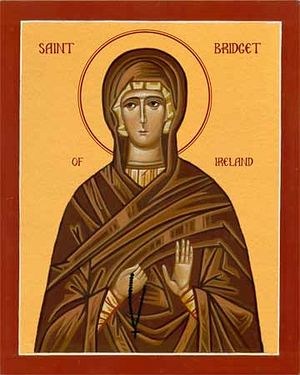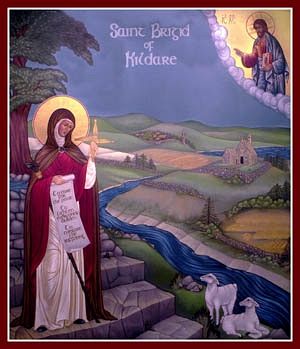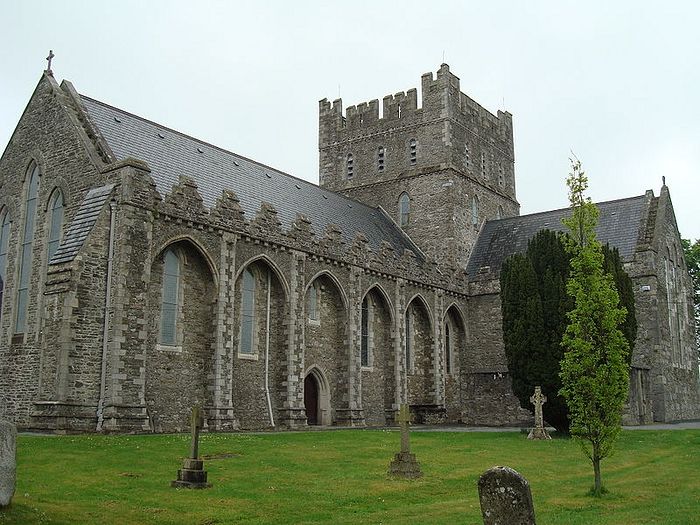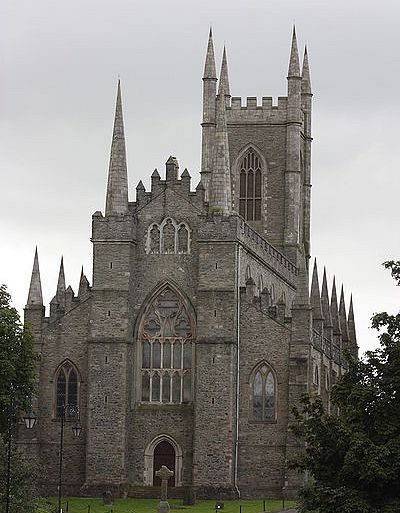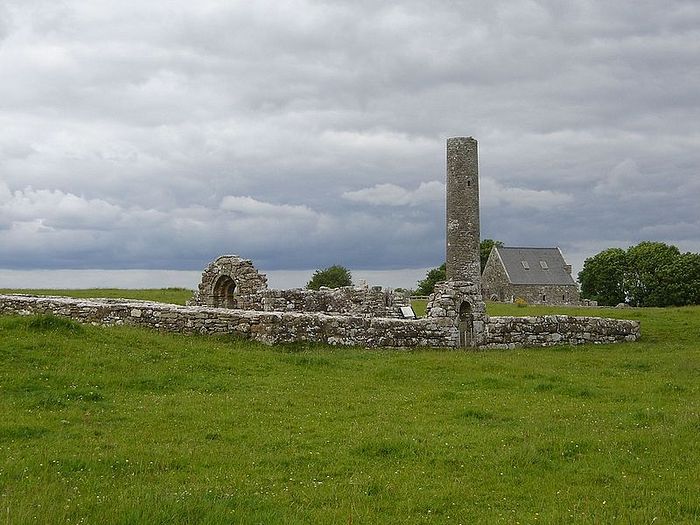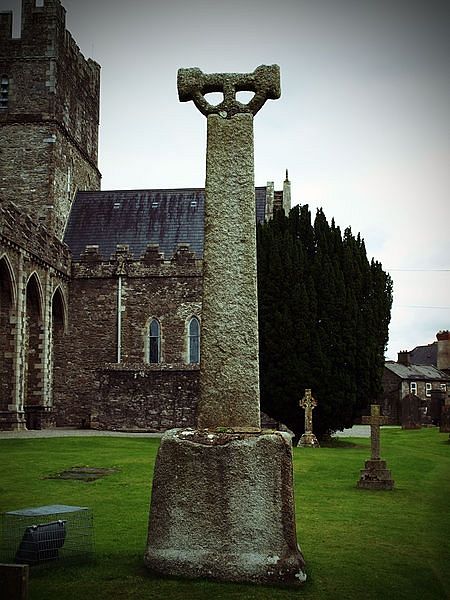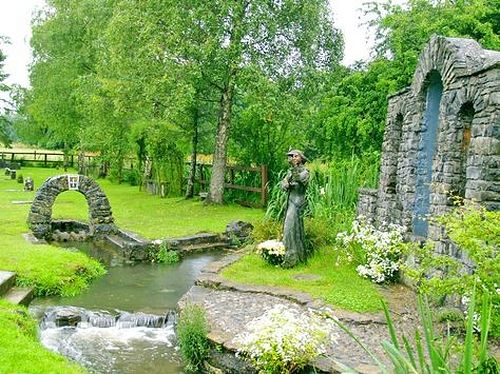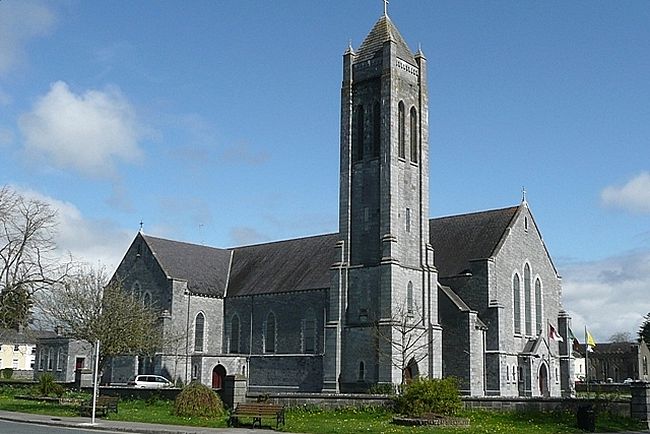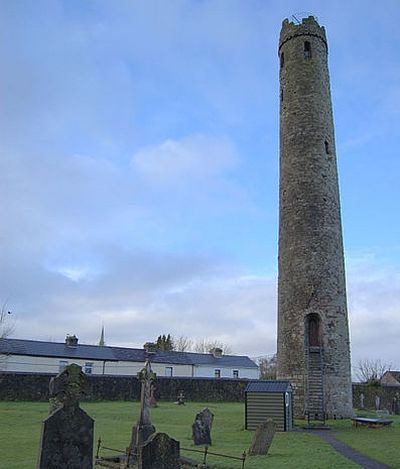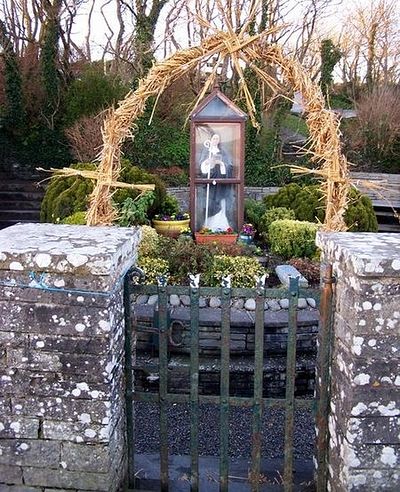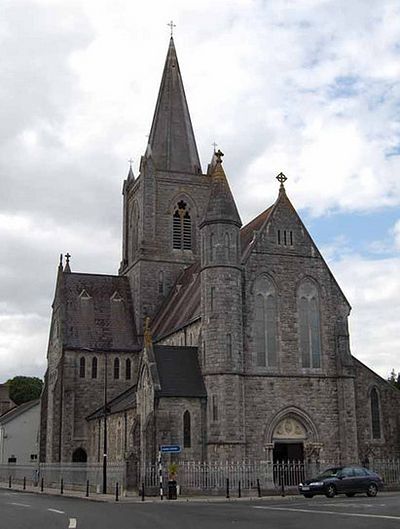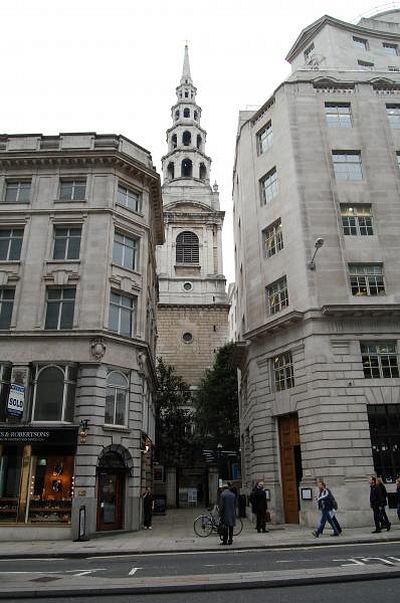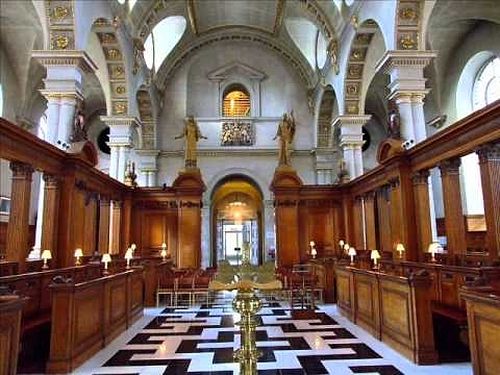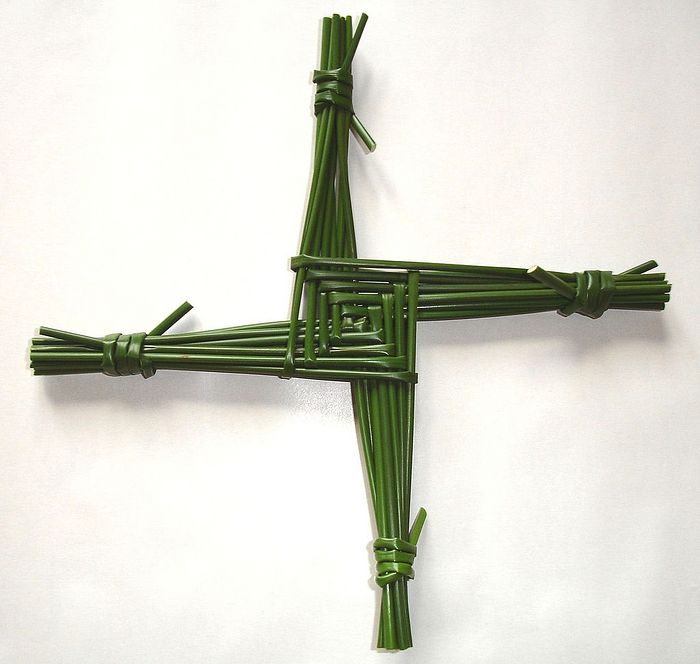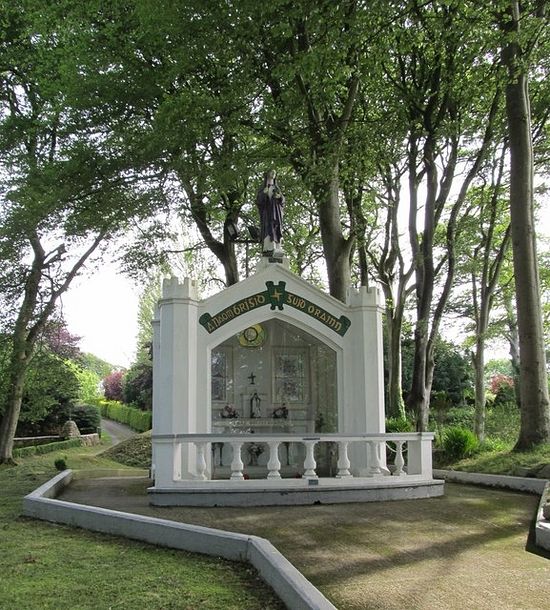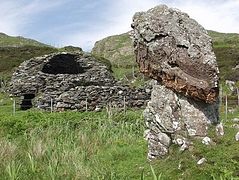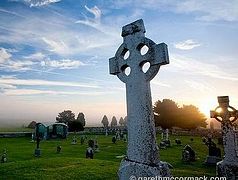The most venerated Irish woman saint, St. Brigid (Bridget, Bride) lived in the second half of the fifth century and the early sixth century. She was most probably born between 450 and 454 and reposed between c. 523 and 527. Her name means “light-bearer” (other possible translations: “power”, virtue”, “exalted one”). In truth the saint by the light of her virtuous life justified her name. She is often nicknamed “Mary of Ireland”1 and “the pillar of Ireland” and is venerated on a par with Sts. Patrick and Columba. The personality of the great saint was quickly surrounded with legends, so she became not only one of the most loved Christian saints of the Emerald Isle, but also one of the most popular characters of Irish folklore and mythology. However, we can trace the major events of her life with certainty.
There are many Old Irish and Latin Lives of our saint, composed soon after her repose and later in the middle ages. The oldest extant Life of St. Brigid was written in the mid-seventh century by St. Cogitosus, a monk of Kildare (feast: April 18/May1). There were also the Lives composed by St. Muirchu, a historian and monk of Leinster (who also wrote his version of St. Patrick’s Life; feast: June 8/21); St. Kilian, an abbot on the island of Inis Cealtra (feast: July 29/August 11); and St. Ulcan, a bishop of Ardbraccan, hymnographer and St. Brigid’s relative (feast: September 4/17)—all of them in the seventh century.
According to one tradition, the holy maiden Brigid was born in Faughart near Dundalk in what is now County Louth in Ireland, and, according to another tradition, in Uinmeras near Kildare. From her childhood Brigid was noted for her beauty, strictness, devotion to God, love, and many miracles. She may have been baptized by St. Patrick and tonsured by either St. Mael of Ardagh or the Holy Bishop Maccaile. It is believed that her father, Dubtach, was a pagan chief in Leinster, and her Christian mother, Brocca, of Pictish descent, was his slave. Later Dubtach’s wife persuaded him to sell Brigid’s mother to a druid. It is believed that her father, the king, was so amazed by his young daughter’s wisdom and kindness that he allowed her to work at his palace as a servant. The saint had been instructed in the Christian faith by her pious mother so she remained free of any pagan influences and temptations at her father’s court. The glory of the pure and kind-hearted young girl, who already worked miracles in her teens, spread far and wide, and the king eventually gave her freedom. When St. Brigid grew up, her father wanted to give her in marriage to a chief in Ulster, but the saint who wanted to become a nun answered that her only Bridegroom was Christ and thus refused a promising marriage.
The holy virgin took the veil at a very young age in about 468. First she lived in prayer and fasting together with seven other virgins near Croghan Hill in Offaly, where she may have founded a monastic community, and then in the valley of Maghlif. Her main achievement was the foundation in about 480 of the double monastery in Kildare in what is now County Kildare in the east of the Irish Republic. At first it was just a tiny cell under an oak tree, but in time it grew into a huge and great monastic community of Kildare (the name “Kill Dara” means “church of the oak”). The ancient oak under the shade of which Brigid built her principal establishment stood till the tenth century. The saint ruled both parts of her double monastery—that is, the abbot of the community for men was subordinate to her (then to her successor, and so on). This continued for many years. St. Brigid invited the holy hermit Conleth (feast: May 4/17) to be the spiritual father in her monastery, and afterwards he was consecrated first bishop of Kildare. A highly reputed co-worker of Brigid, a brilliant metalworker, who copied and illuminated many manuscripts, St. Conleth was widely venerated after his death in c. 519.
The most popular woman saint of Ireland, St. Brigid is ranked as the second patron of this land after St. Patrick. After founding her main monastery she carried on the apostolic labors of St. Patrick in converting the pagans to Christ and encouraging the Christian and ascetic way of life among the island’s inhabitants. She had a great influence on her contemporaries with her extraordinary abilities, learning, intelligence and miracles. The monasteries founded by her and her disciples across Ireland contributed enormously to the promotion of monasticism, piety and the Christianization of Ireland.
During her life, St. Brigid founded several other convents and actively developed the life of these communities. In her youth she travelled a lot and preached Christ. Many churches and chapels dedicated to St. Brigid in Ireland indicate her activity in these areas. St. Brigid visited her daughter monasteries regularly and each visit was accompanied by miracles. With the sign of the cross she would cast out demons, heal illnesses; she converted and turned sinners to repentance. The very presence of this grace-filled woman inspired people with love for God. There are many holy men and women who were St. Brigid’s disciples or at least were taught or blessed by her. The most remarkable of them is St. Dara, a blind nun from Kildare Monastery.
Sts. Brigid and Dara used to sit in the open for hours and converse about spiritual things. Contemplating the beauty of nature, the sunlight, trees and flowers, one day Brigid took great pity on Dara, made a sign of the cross over her head, read a prayer—and, lo and behold, St. Dara’s eyes were opened and she saw the world created by God for the first time! The nun looked for a while and then said to Brigid: “Dear mother! Please, close my eyes again! For when I can see the world with my physical eyes, I see the Creator less clearly with the inner eyes of my soul. Bring me back to the beautiful darkness!” St. Brigid prayed—and St. Dara became blind again. Among her sainted followers were also St. Blath (Flora), a cook at Kildare Monastery noted for her holy life (feast: January 29/February 11); St. Brigid (Briga) of Kilbride, who is commemorated on January 21/February 3; and St. Darlugdach, the second abbess of Kildare who is feasted on February 1/14 together with its foundress.
St. Brigid is especially venerated for her love, compassion, mercy, care and generosity for everybody. It was related that as a girl she once gave away all the butter she was carrying home to paupers. Fearing that her mother would be disappointed, she prayed—and all the empty pails in the house were miraculously filled with butter! On one occasion as a young maiden she met a pauper in the street and without thinking took off her cloak and shoes and gave them to him. In all accounts of that time St. Brigid is praised for her miracles and works of love: She would distribute food and other gifts among the poor, heal the sick, and she never turned down anybody who needed help. Remarkably, the Lord bestowed a very rare gift upon His holy abbess: “multiplying bread”. Through the prayers of the holy maiden, who imitated Christ, her monastery never ran out of supplies of butter, cheese, meat and many other treats for guests—there was always sufficient food and drink for everybody. On one occasion the water at her monastery miraculously turned into low-alcoholic beer to quench the thirst of her guests—priests who had suddenly arrived. Even the cows of St. Brigid’s Monastery provided three times as much milk as an ordinary cow can give, sometimes in enormous quantities contrary to the laws of nature, so that it would suffice for all the bishops or other guests. Hospitality was one of the top priorities of the saint!
The “monastery under the oak” was initially very poor and its dwellers needed to exert themselves and toil day and night to arrange things in it and manage it. St. Brigid cheered up her sisters, taught them patience, supported those who grew faint from exhaustion, treated the sick and feeble, practiced daily almsgiving—in a word, she became all things to all people (cf. 1 Cor. 9:22). The glory of the saint spread all over the Irish land.
Amazingly, the holy abbess wasn’t afraid to cure lepers and insane people—those who had been rejected by society. No other Life of a saint can boast so many accounts of healing lepers! Brigid felt no aversion to anybody, seeing the image of God in every neighbor. The saint possessed the gift of discernment: sometimes people appealed to her as to a judge, when there was no hope of justice on earth. Students, priests and even bishops from across Ireland flocked to St. Brigid, seeking her advice, support and encouragement. She was regarded as an eldress, a vessel of wisdom and many other gifts of the Holy Spirit.
Different sources claim that St. Brigid was a friend of St. Patrick. Though there is no convincing evidence to support this, we know that St. Brigid visited some places closely associated with the apostle of Ireland. Thus, she visited the province of Connacht in the west, where she may have founded numerous churches—as we know it was there (in what is now county Mayo) that St. Patrick spent forty days and forty nights in contemplation and prayer on the mountain of Crochan, since known as Croagh Patrick. Indeed Brigid was a model of abstinence, purity, and active love for neighbors to her sisters. It was said that as an abbess Brigid herself tended flocks of sheep, milked cows, reaped the crops, made butter and brewed beer at her monastery. Meanwhile, the venerable mother would often retreat for long solitary prayer and silence.
Among Brigid’s spiritual friends were many saintly figures of the time. One of them was St. Gildas the Wise of Wales. According to legend, when this saint arrived in Ireland St. Brigid sent a messenger to him, and St. Gildas gave her through the messenger a hand-bell made by him. The abbess kept this hand-bell as a great relic. The holy mother had several of her own bells (a typical Celtic tradition) and she may have donated one of them to the church (later monastery) of Glastonbury in England, where it was kept for many centuries. Among the miracles associated with Brigid there are some very touching ones. One day the saint toiled all day long under torrential rain and got wet to the skin. Arriving home, she hung her clothes to dry up on a sunbeam, mistakenly taking it for a branch of a tree out of fatigue. And the holy maiden’s garments were suspended on the sun beam as if it were a branch!
After the repose of St. Brigid, Kildare Monastery developed into a very important center of monastic life and learning in Ireland. It is known that Brigid was the patron of many arts and crafts. Thus, she opened an art school in Kildare where students were taught to work on metal, decorate manuscripts and so forth. The Kildare scriptoria produced many real masterpieces, the most notable example being the illuminated Book of Kildare, which according to the testimony of the thirteenth-century traveler and writer Gerald of Wales, was “not the book of men but of angels”.
The fifteenth-century vellum Book of Lismore, which is based on earlier manuscripts and includes the Lives of several Irish saints, contains a panegyric to St. Brigid, which has the following passages (translation by the Irish Celtic scholar Whitley Stokes: 1830-1909): “Everything that Brigid would ask of the Lord was granted to her at once. For this was her desire: to satisfy the poor, to expel every hardship, to spare every miserable man. None was ever more retiring, more modest, more gentle, more humble, more wise, or more harmonious than she. She was abstinent, innocent, prayerful, patient; she was glad in God's commandments; she was firm, humble, forgiving, loving; she was a consecrated casket for keeping Christ’s Body and His Blood; she was a temple of God. Her heart and her mind were a throne of rest for the Holy Spirit. She was simple before God; she was compassionate towards the wretched; she was splendid in miracles and marvels; wherefore her name among created things is Dove among birds, Vine among trees, Sun among stars...
“She helps everyone who is in strait and danger; she banishes pestilence; she quells the anger and the storm of the sea. She is the prophetess of Christ, she is the Queen of the South [implying that St. Patrick is the apostle of the north]; she is the Mary of the Gael [Ireland].”
Before her death, which she predicted herself, St. Brigid was given Communion by St. Ninnidh, one of “the twelve apostles of Ireland”. The relics of Sts. Brigid and Conleth, venerated by everybody, were enshrined in the beautiful wooden church in Kildare. Till the end of the ninth century St. Brigid’s relics rested at the right of the altar of Kildare Cathedral and countless pilgrims flocked to them. About the year 878, for safety reasons as there was danger of a Viking attack, her relics may have been translated to the town of Downpatrick. In 1185 at the cathedral of Downpatrick the relics of three saints were reputedly discovered: the supposed relics of Sts. Brigid, Patrick, and Columba.
After St. Brigid’s death her veneration can be compared with that of St. Patrick, especially till the eighth century when the See of Armagh, reputedly founded by Patrick, became dominant in the Irish Church. Many churches were dedicated to her, many songs, hymns and prayers were composed in her honor. Gradually her veneration spread from Ireland to the larger part of Western Europe, where in the age of the missionaries (the majority of them were Irish) no less than seventy early monasteries bore the name of St. Brigid! In Kildare, where our saint founded her monastery (initially a humble establishment in an oak grove), a perpetual flame as a symbol of the Holy Spirit was tended in honor of Brigid for at least 1,000 years (another Celtic tradition)—it was held in veneration as many miracles were wrought through it, too. The Diocese of Kildare already in the saint’s lifetime was nicknamed “the see of the bishop and the virgin”.
Accounts of St. Brigid’s life were copied and circulated in many countries of Europe; they were translated into Old French, Old English, Old German and other languages. In addition to a host of churches dedicated to St. Brigid in Ireland, there were nineteen ancient churches dedicated to her in England and approximately the same number in Wales. The bay in the Welsh county of Pembrokeshire is called St. Brides Bay after her, and one of the neighboring villages is called St. Brides. This is indicative of a very close link between Welsh and Irish monasticism. Several localities of Wales are called “Llansantffraid”, meaning “church of Saint Bride”. This saint is still venerated in Portugal, Alsace, Flanders and other countries and regions of Europe, along with the USA and other countries outside the European continent with significant Irish communities.
St. Brigid is a patroness of poets, blacksmiths, doctors, nurses, midwives, children, students, women in labor, dairymaids, farmers, seamen, travelers, nuns, those seeking priestly ministry, scholars, paupers, and agriculture. She is usually depicted with a cow lying at her feet, or holding a crozier or a lamp in her hand. A marvelous relic is still kept at the National Museum in Dublin: it is her “shoe-shrine” (believed to have contained her real shoe in the past), made of silver and brass, set with jewels. A portion of St. Brigid’s tunic is still kept in the Belgian town of Bruges, at St. Donatian’s Church. Her supposed head relic has been preserved at the Church of St. John the Baptist at Lumiar near Lisbon, Portugal, and another particle of her relics is probably at St. Martin’s Church in Cologne, Germany.
Hundreds of places of Ireland and Scotland are named after the holy virgin Brigid. The town of East Kilbride in Lanarkshire, Scotland, bears her name (“Kilbride” means “church of Bride” in Gaelic). The presence of such place names in Scotland suggests that monks of Kildare once took St. Brigid’s rule and veneration to Scottish soil. The village of West Kilbride in North Ayrshire, on the west coast of Firth of Clyde in Scotland, is another example. According to tradition, the village is named after a chapel or a cell in honor of our saint that used to stand here, and a local legend has it that the holy abbess herself built a monastic community on this spot during her travels in Scotland. You can find the toponym “Kilbride” in Ireland, Scotland and even Canada! A village in Aberdeenshire in Scotland is called Brideswell—that is, “St. Brigid’s well”. The place known as Tubberbride in the Irish county Sligo means the same. The Welsh village of Llansantffraid-ym-Mechain in Powys near the English border is named for Brigid.
The town of Downpatrick is situated in County Down in Northern Ireland. The local Holy Trinity Cathedral was founded not later than the twelfth century. Approximately from 1177 there was also a Benedictine monastery there. It was at Downpatrick Cathedral that the supposed relics of Sts. Brigid, Patrick and Columba rested for some centuries. This cathedral has a very turbulent history. In 1245 it was severely damaged by an earthquake, burned down by Edward the Bruce (a younger brother of King Robert the Bruce of Scotland) in 1315, and afterwards was restored, ruined and rebuilt again more than once. In 1539 the monastery at Downpatrick ceased to exist, and two years later the cathedral was destroyed. After that it lay in ruins for two centuries until it was rebuilt between 1790 and 1818. It belongs to the Anglican Church of Ireland. Among its treasures are three ancient crosses (of the ninth, tenth and twelfth centuries), a twelfth-century granite font and, above all, the supposed grave of St. Patrick.
The town of Kildare in the county with the same name stands on the site of St. Brigid’s main monastery. The town is dominated by the Church of Ireland’s Cathedral dedicated to its heavenly patroness. A simple wooden church stood here in the time of the holy abbess, but her veneration grew so rapidly that soon after her repose a cathedral towered on the site which became the resting place of her relics. For many years the Diocese of Kildare was unique in that its bishop obeyed the abbess of Kildare Monastery—and it was not a rarity in the early Irish Church when the authority of an abbot or an abbess was higher than that of a bishop. Between 835 and 1000 the cathedral in Kildare was attacked by barbarians more than fifteen times! By 1220 the cathedral had been reduced to ruins. The church was restored in a short period (1223-1230), but by the time of the Reformation everything had been in neglect, and following the Reformation the cathedral again lay in ruins.
Large-scale restoration work was carried out between 1875 and 1896. One of its stained glass windows depicts the lives of Sts. Brigid, Patrick, and Columba. There is a unique Celtic round tower near the cathedral that stands about 108 feet high, which makes it the second tallest tower in Ireland. There is also a partly surviving Celtic cross close to the cathedral. Besides this, there are ruins of the ancient chapel where a perpetual flame was kept in memory of Brigid in Kildare. And, lastly, there is a very pretty holy well of St. Brigid near Kildare, situated in a beautiful nook in a quiet park. There is a bronze statue of St. Brigid and a few stones, locally known as “St. Brigid’s slippers”, beside the well. Some people still leave votive offerings at the well in thanks for miraculous cures.
At Faughart, St. Brigid’s supposed birthplace, there is a very ancient holy well of St. Brigid, complete with ruins of an early St. Brigid’s Church, and other holy wells, old and new chapels, crosses, stones (symbolizing one or another event in her life) and a Lourdes-style shrine nearby, in an idyllic setting. Among other holy sites associated with St. Brigid in Ireland let us mention: St. Brigid’s Church, well and cross at the village of Liscannor in County Clare; St. Brigid’s RC church in Portumna in County Galway; St. Brigid’s RC church in Rolestown in county Fingal; St. Brigid’s RC church in Ballintra in county Donegal; St. Brigid’s Church on Inis Cealtra, or “Holy Island” in Irish, situated in Lough Derg, a lake in County Clare—ruins of six churches, ancient monastic cells, monastic burials and a round tower are also preserved on this holy island and ancient monastic site; St. Brigid’s church in Talbotstown in county Wicklow; St. Brigid’s Roman Catholic church in Coan in County Kilkenny; St. Brigid’s Roman Catholic church in Kilcurry in Louth, near her birthplace, which has a particle of her relic (possibly her skull); St. Brigid’s church in Highwood County Sligo; a new beautiful Roman Catholic church of St. Brigid in Belfast, the capital city of Northern Ireland; the Church of Ireland church in Castleknock near Dublin—a Benedictine Monastery in honor of St. Brigid existed here from 1185 till the Reformation.
Let us also mention the town of Clara in County Offaly where our saint may have founded one of her first monasteries. It comprised a little wooden church with other monastic buildings grouped around it. In the twelfth century the wooden monastery was replaced with a stone one. Only the ruins of that monastery survive and one ancient church dedicated to St. Brigid. Interestingly, there are a Church of Ireland church and a Roman Catholic church in this town in our days, and the Catholic church holds a particle of the saint’s relics. And these are only some of the sites associated with Brigid in Ireland. In the early twentieth century County Kildare alone had several St. Brigid holy wells whose water healed headache and toothache. There are over 100 such holy wells scattered all over the island. One of such ancient wells of St. Brigid can be found in Mullingar, county Westmeath—it dates from the seventh century.
In Wales, there is a parish church dedicated to our saint in the village of Trearddur Bay on the west coast of Ynys Gybi (Holy Island, “St. Cybi’s Island) off the coast of Anglesey. An ancient church, built in the tenth century and largely rebuilt in the nineteenth century, stands in the abandoned village of St. Brides Netherwent in the Welsh county of Monmouthshire. Another very early church dedicated to her can be found in the Welsh hamlet of St. Brides Wentloog near the city of Monmouth.
The most famous St. Brigid’s Church on English soil is St. Bride’s Church in the City of London. This ancient church stands on Fleet Street, which derives its name from the River Fleet that once ran here. The first church on this site was built in the sixth century. According to one version, it was built by St. Brigid herself during her travels across Britain, and, according to another much more likely version—by Irish monks. Throughout its history the church was rebuilt and extended seven times. St. Bride’s is famous as a symbol and spiritual center for journalists, publishers and media workers. Prayer for those engaged in this occupation has been going on here for 500 years, and some people of that profession still attend this church.
It all began in 1500 when a printer named Wynkyn de Worde installed a printing press beside this church and set up the first printing establishment in England. From that time there appeared more and more printing houses nearby, trade in printed output developed, and printers, publishers, writers and highly educated priests began to settle in Fleet Street. The origins of the multi-tier wedding cake are connected with this church. In 1703 Thomas Rich, an apprentice of a wealthy baker, fell in love with his employer’s daughter and became her husband. Wishing to amaze his bride on their wedding day, Thomas was inspired by the high spire of St. Bride’s and baked a cake taking this spire as a model. And the tradition of baking such cakes still goes on.
In the Great Fire of London in 1666 this church was destroyed. St. Bride’s was rebuilt in its full glory by Christopher Wren by 1675, and by 1701 the new spire was completed: since that time the total height with the spire has been around 230 feet. In 1940 the church roof and interior were seriously damaged during German bombing. The church was fully restored by 1957. During the restoration work the foundations of older churches were found under the floor, including the earliest church. Also mass burials of various epochs were discovered along with interesting artifacts and the remains of a Roman building. The church interior is richly decorated with oak and is an excellent example of Baroque.
A museum devoted to the church’s history is in the crypt. The names of many prominent figures are connected with this church: the lexicographer, scholar and writer Samuel Johnson—the author of the first Dictionary of the English Language; the politician and diarist Samuel Pepys (baptized in this church); the poet John Milton; the playwright John Dryden; the painters Joshua Reynolds and William Hogarth; to say nothing of Shakespeare and Dickens. Among celebrities buried within St. Bride’s are the composer of Church music Thomas Weelkes, the novelist Samuel Richardson, and the poet Richard Lovelace. In the sixteenth century the Book of Common Prayer was first used precisely in this church, which is noted for its rich music traditions, choir and organ. Queen Elizabeth II visited St. Bride’s in 1957 and in 2007.
The most famous St. Brigid’s Church in Scotland is situated in the west of the city of Glasgow and belongs to the Episcopal Church of Scotland. Churches which have our saint as their patron can be found in Australia (no fewer than fifteen), Belgium (a chapel at Fosses-la-Ville; farmers near the town of Amay had a custom of blessing the earth in her honor and taking it to their stables and cowsheds), the USA, Canada (including Ottawa and Toronto), Germany (including Kronenburg, Cologne, and Büraburg), the Netherlands, France, Italy, Austria, and Sweden. St. Brigid of Kildare should not be confused with the Catholic saint, Bridget (Birgitta) of Sweden, who lived in the fourteenth century.
The name “Brigid” in its various forms and variations is still a popular baptismal and a given name for girls in Ireland and other countries. Icons, stained glass images and statues of St. Brigid of Kildare can be found in a host of churches where she is venerated. There is a new Orthodox service to St. Brigid in English as well. Those who venerate St. Brigid and love the Celtic saints have a custom of greeting each other on St. Brigid’s day, February 1/14, with the following blessing: “Faoibhrat Bride sinn!—May we be under Saint Brigid’s mantle!”
By the way, the famous St. Brigid’s mantle, or cloak, features in some of her miracles, particularly in one of the earliest ones. Before founding Kildare Monastery the holy virgin approached the King of Leinster, asking for the land on which to establish the community. The place she chose was perfect for monastic life, in a forest, with a lake and fertile fields nearby. But the king turned her down. The saint set to praying hard with her sisters for the softening of the ruler’s heart. Then she approached him again and requested: “Give me as much land as my mantle will cover.” Seeing her little mantle, the king agreed. But Brigid then commanded her four helpers each to take a corner of the mantle and move in all four directions. As they walked, the mantle miraculously grew and spread, until it covered many acres of land. Awe-stricken, the king and his family realized that a true servant of God was in front of them, so he gave her this land and became a patron of her monastery.
St. Brigid’s day is one of the most beloved holy days among the Irish to this day. There were many folk traditions celebrating it. On the eve of the feast, people would cook a special dish in her honor, leave a piece of cloth or a ribbon on the door or windowsill so that the saint would bless it at the night and it would possess a special curative power for the next year; they would visit her holy wells, and go from home to home with her image raising money for charities. To this day rural people in Ireland make “St. Brigid crosses”2 for the eve of her feast using straw, rushes, reeds, grass, or hay, and hang them above the door of the kitchen as well as in the domestic animal sheds to secure the saint’s blessing, success and good health for the whole year. Many people still leave pots with milk or cottage cheese on their windowsills on the eve of her festival, asking Brigid to bless their produce and agricultural labor. Many of these dishes are then consumed by the poor, which is in the spirit of St. Brigid who would always feed the hungry and give shelter to strangers and the homeless.
Holy Mother Brigid of Ireland, pray to God for us!

